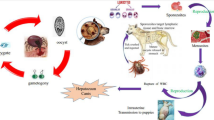Abstract
A seroepidemiological study was conducted in 308 dogs to determine the presence of antibodies toRickettsia conorii, using an indirect immunofluorescence assay (IFA). Seven of the provinces of the Castilla y León region (Burgos, León, Palencia, Salamanca, Soria, Valladolid, and Zamora) were covered by the study. Of the 308 dogs analysed, 72 (23.4%) showed significant titers by IFA (1/40 or higher). Seroprevalences were significantly differents between provinces of origin of the animals. These were below 30% in almost all the provinces studied, except for Salamanca province, where the percentage of seropositive dogs was much greater (93.3%). Potential risk factors (presence of ticks on the animals, age, sex, use, habitat, and season) relating to the presence of Mediterranean spotted fever, or Boutonneuse fever, were evaluated. Animals used for guard or pastor activities and those living in rural areas (these factors are closely linked), together with those suffering from tick infestation, had significantly higher seroprevalence than the remainder. The frequency of seropositive dogs increased during the summer months, and these coincide with the period of greatest activity by the vector. Sex and age variables were not identified as risk factors.
Similar content being viewed by others
Abbreviations
- IFA:
-
indirect immunofluorescence assay
- msf:
-
mediterranean spotted fever
References
Mansueto S, Vitale G, Miceli MD, Tringali G, Quartararo P, Picone MD, Occhino C. A seroepidemiological survey of asymptomatic cases of Boutonneuse fever in western Sicily. Trans Roy Soc Trop Med Hyg 1984; 78: 16–18.
Gonzalez JP, Fiset P, Georges AJ, Saluzzo JF, Wisseman CL. Approche serologique sur l'incidence des rickettsioses en Republique Centrafricaine. Bull Soc Pathol Exot Filial 1985; 78: 153–156.
Kelly P, Mason PR, Matthewman LA, Raoult D. Seroepidemiology of spotted fever group rickettsial infections in human in Zimbabwe. J Trop Med Hyg 1991; 94: 304–309.
Gutman A, Schreiber H, Taragan R. An outbreak of tick typhus in the coastal plain of Israel: 13 cases from the Sharon area. Trans Roy Soc Trop Med Hyg 1973; 67: 112–121.
Fan MY, Walker DH, Yu SR, Liu QM. Epidemiology and ecology of rickettsial diseases in the People's Republic of China. Rev Infect Dis 1987; 9: 823–840.
Segura F, Font B. Resurgence of Mediterranean spotted fever in Spain. Lancet 1982 (ii): 280.
Otero R, Fenoll A, Casal J. Resurgence of Mediterranean spotted fever. Lancet 1982 (ii): 1107.
Suárez-Ferreiro P, Rodríguez-Rodríguez JA, Castro JM, Olmeda-García AS, Solana A. Encuesta seroepidemiológica de la infección porRickettsia conorii (fiebre exantemática mediterránea) en el perro. Med Vet 1992; 9: 521–526.
Gilot B, Laforge ML, Pichot J, Raoult D. Relationships between theRhipicephalus sanguineus complex ecology and Mediterranean spotted fever epidemiology in France. Eur J Epidemiol 1990; 6: 357–362.
Herrero C, Pelaz C, Alvar J, Molina R, Vázquez J, Anda P, Casal J, Martín-Bourgon C. Evidence of the presence of spotted fever group rickettsiae in dogs and dog ticks of the central provinces in Spain. Eur J Epidemiol 1992; 8: 575–579.
Clerc B, Lecomte R. Cas d'observation clinique: une rickettsiose chez le chien. Rev Med Vet 1974; 150: 189–192.
Raoult D, Nicolas N, De Micco PH, Gallais H, Casanova P. Aspects epidemiologiques de la fievre boutonneuse méditerraneenne en Corse du Sud. Bull Soc Path Exot 1985; 78: 446–451.
Espejo E, Alegre MD, Font B, Font A, Segura F, Bella F. Antibodies toRickettsia conorii in dogs: Seasonal differences. Eur J Epidemiol 1993; 9: 344–346.
Price WH. The epidemiology of Rocky Mountain spotted fever, II: Studies on the biological survival mechanisms ofR. rickettsii. Am J Hyg 1954; 60: 292–319.
Norment BR, Burgdorfer W. Susceptibility and reservoir potential of the dog to spotted fever group rickettsiae. Am J Vet Res 1984; 45: 1706–1710.
Breitschwerdt EB, Moncol DJ, Corbett WT, MacCormack JN, Burgdorfer W, Ford RB, Levy MG. Antibodies to spotted fever-group rickettsiae in dogs in North Carolina. Am J Vet Res 1987; 48: 1436–1440.
Mansueto S, Vitale G. Antibodies toRickettsia conorii in dogs in western Sicily. Trans Roy Soc Trop Med Hyg 1984; 78: 681–682.
Dean AG, Dean JA, Burton AH, Dicker RC. EPI INFO, Version 5: A wordprocessing, database, and statistics program for epidemiology on microcomputers. Stone Mountain, GA: USD Incorporated, 1990.
Raoult D, Toga B, Dunan S, Davoust B, Quilici M. Mediterranean spotted fever in the south of France: Serosurvey of dogs. Trop Geogr Med 1985; 37: 258–260.
Kelly PJ, Mason PR. Tick-bite fever in Zimbabwe: Survey of antibodies toRickettsia conorii in man and dogs, and rickettsia-like organisms in dog ticks. South African Med J 1991; 80: 233–236.
Herrero C, Pelaz C, Martín-Bourgon C. Isolation of an agent of the spotted fever group rickettsia from tick eggs in Madrid, Spain. Epidemiol Infect 1992; 108: 555–557.
Herrero-Herrero JI, Ruiz-Beltrán R, Martín-S ánchez AM, Garcia EJ. Mediterranean spotted fever in Salamanca, Spain: Epidemiological study in patients and serosurvey in animals and healthy human population. Acta Tropica 1989; 46: 335–350.
Anónimo. Comentario epidemiológico de las enfermedades de declaración obligatoria nacional. Año 1992. Bol Epidemiol Microbiol 1992; 1: 2–6.
Espejo-Arenas E, Font-Creus B, Alegre-Segura MD, Segura-Porta F, Bella-Cueto F. Seroepidemiological survey of Mediterranean spotted fever in an endemic area (śVallés Occidental’, Barcelona, Spain). Trop Geogr Med 1990; 42: 212–216.
Espejo E, Font B, Bella F, Segura F. Climatic factors in resurgence of Mediterranean spotted fever. Lancet 1986 (i): 1333.
Breitschwerdt EB, Walker DH, Levy MG, Burgdorfer W, Corbett WT, Hurlbert SA, Stebbins ME, Curtis BC, Allen DA. Clinical, hematologic, and humoral immune response in female dogs inoculated withRickettsia rickettsii and Rickettsia montana. Am J Vet Res 1988; 49: 70–76.
Author information
Authors and Affiliations
Rights and permissions
About this article
Cite this article
Delgado, S., Cármenes, P. Canine seroprevalence ofRickettsia conorii infection (Mediterranean spotted fever) in Castilla y León (northwest Spain). Eur J Epidemiol 11, 597–600 (1995). https://doi.org/10.1007/BF01719315
Accepted:
Issue Date:
DOI: https://doi.org/10.1007/BF01719315




